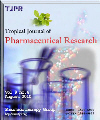
|
Tropical Journal of Pharmaceutical Research
Pharmacotherapy Group, Faculty of Pharmacy, University of Benin, Benin City, Nigeria
ISSN: 1596-5996
EISSN: 1596-5996
Vol. 11, No. 2, 2012, pp. 169-175
|
 Bioline Code: pr12021
Bioline Code: pr12021
Full paper language: English
Document type: Research Article
Document available free of charge
|
|
|
Tropical Journal of Pharmaceutical Research, Vol. 11, No. 2, 2012, pp. 169-175
| en |
Effect of Process Factors on the Properties of Doxycycline Nanovesicles
Honary, S & Zahir, F
Abstract
Purpose: To develop and evaluation ascorbyl palmitate niosomes in order to achieve a transdermal and/or systemic nanocarier of doxycycline.
Methods: Vesicles were formed from ascorbyl palmitate in combination with cholesterol and a negatively charged lipid, dicetyl phosphate. Niosomes were prepared by film hydration method followed by sonication in which aqueous doxycycline solution (in phosphate buffered saline) was encapsulated in the aqueous regions of the vesicles. The vesicles were evaluated for entrapment and in vitro release as well as for their thermal properties and shape by ultraviolet spectroscopy (UV), differential scanning calorimetry (DSC) and scanning electron microscopy (SEM), respectively. The effect of process conditions - sonication time, pH, hydration temperature and centrifuge speed - on niosome properties was investigated.
Results: DSC of pure lipids, vesicles dispersion and mixture of lipids confirmed the formation of niosomes. Other results show that >90 % of drug was entrapped in the vesicles and the vesicles were spherical in shape. Drug release from the vesicles was slow (<60 % after 8 h). Nanovesicle size was significantly (p<0.05) affected by sonication time and hydration pH. Although hydration temperature of 100ºC promoted the production of smaller vesicles, this temperature would likely cause drug degradation.
Conclusion: The use of ascorbyl palmitate along with cholesterol and a charge inducer (dicetyl phosphate) yielded vesicles that satisfactorily encapsulated doxycycline solution. The resulting system can be applied for the formulation of doxycycline niosomes.
Keywords
Doxycicline, Vesicles, Drug delivery, Ascorbyl palmitate, Niosomes
|
| |
© Copyright - 2012 Tropical Journal of Pharmaceutical Research
Alternative site location: http://www.tjpr.org
|
|
